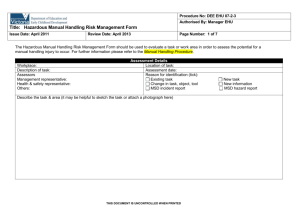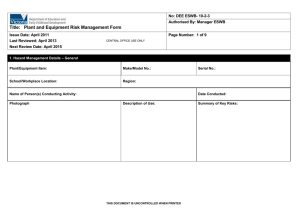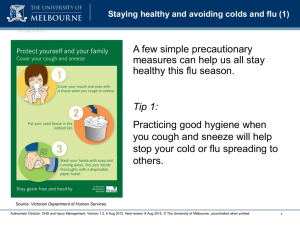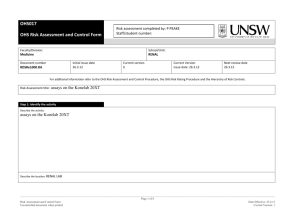CONTRACTOR CHECKLIST - Department of Education and Early
advertisement
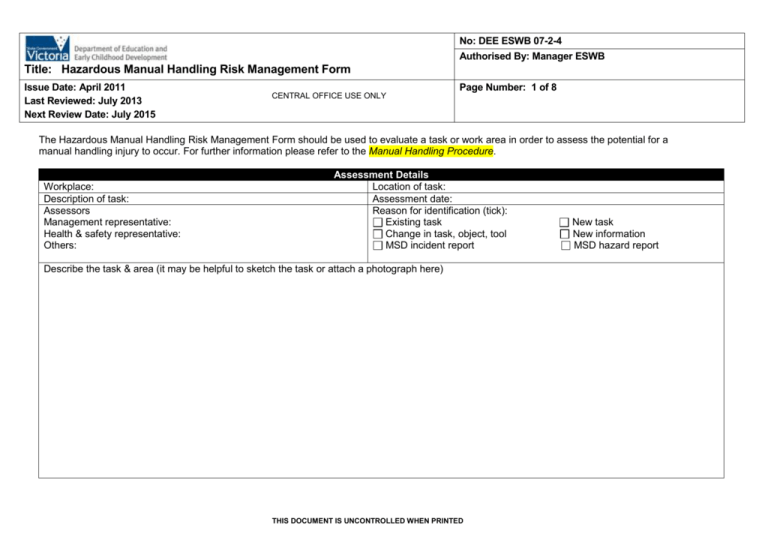
No: DEE ESWB 07-2-4 Authorised By: Manager ESWB Title: Hazardous Manual Handling Risk Management Form Issue Date: April 2011 Last Reviewed: July 2013 Next Review Date: July 2015 CENTRAL OFFICE USE ONLY Page Number: 1 of 8 The Hazardous Manual Handling Risk Management Form should be used to evaluate a task or work area in order to assess the potential for a manual handling injury to occur. For further information please refer to the Manual Handling Procedure. Workplace: Description of task: Assessors Management representative: Health & safety representative: Others: Assessment Details Location of task: Assessment date: Reason for identification (tick): Existing task Change in task, object, tool MSD incident report Describe the task & area (it may be helpful to sketch the task or attach a photograph here) THIS DOCUMENT IS UNCONTROLLED WHEN PRINTED New task New information MSD hazard report No: DEE ESWB 07-2-4 Authorised By: Manager ESWB Title: Hazardous Manual Handling Risk Management Form Issue Date: April 2011 Last Reviewed: July 2013 Next Review Date: July 2015 CENTRAL OFFICE USE ONLY Page Number: 2 of 8 Documentation Relevant Legislation/Standards/Documentation Are instruction manuals accessible? Y/N Y Comments N Is a Safe Work Procedure (SWP) required to be Y N developed? (complete once risk assessment has been conducted) Occupational Health and Safety Act 2004, Occupational Health and safety Regulations 2007, Victorian Code of Practice for Manual Handling 2000, Key reference material: Hazardous Manual Handling Tasks Draft Code of Practice 2010. Risk Assessment Step 1a: Does the task involve repetitive movement or sustained or awkward postures? Think about the work area and each stage of the work to be performed. Does the task involve repetitive (more than twice a minute) movements; or sustained (more than 30 seconds at a time) postures and/or awkward postures? Bending the back forwards or sideways more than 5 degrees Bending the back of head backwards for more than 5 degrees Bending the head forwards or sideways more than 20 degrees Twisting the back more than 20 degrees Twisting the neck more than 20 degrees Working with one or both hands above shoulder height Reaching forwards or sideways more than 30 cm from the body Reaching behind the body This action happens when… e.g. Source of Risk picking up chemical containers in the chemical storeroom from ground level. e.g. chemical containers are stored too low. Yes Yes Yes Yes Yes Yes Yes Yes Squatting, kneeling, crawling, lying, semi-lying or jumping Yes Standing with most of the body’s weight on one leg Yes Twisting, turning, grabbing, picking or wringing actions with the fingers, hands or arms Yes THIS DOCUMENT IS UNCONTROLLED WHEN PRINTED Duration of task e.g. 5 times per minute for 3 hours a day No: DEE ESWB 07-2-4 Authorised By: Manager ESWB Title: Hazardous Manual Handling Risk Management Form Issue Date: April 2011 Last Reviewed: July 2013 Next Review Date: July 2015 CENTRAL OFFICE USE ONLY Working with the fingers close together or wide apart Yes Very fast movements Yes Excessive bending of the wrist Yes Step 1b: Does the task involve any repetitive or sustained forces? Page Number: 3 of 8 This action happens when… Source of Risk e.g. loading books on to a trolley e.g. trolley is on the ground per minute for 3 hours a day Think about the work area and each stage of the work to be performed. Does the task involve: repetitive (more than twice a minute) movements; or Sustained (more than 30 seconds at a time) postures and/or awkward postures? Lifting or lowering Yes Carrying with one hand or one side of the body Yes Yes Yes Yes Exerting force with one hand or one side of the body Pushing, pulling or dragging Exerting force while in an awkward posture e.g. supporting items while arms or shoulders are in awkward posture Gripping with the fingers pinched together or held wide apart Holding, supporting or restraining any object, person, animal or tool Step 2 – Does the task in step 1a or 1b involve long duration? More than 2 hours over a whole shift Yes Continually for more than 30 minutes at a time Yes Duration of task e.g. 5 times Yes Yes Risk Rating (refer to Risk Matrix: Appendix 1) Conseq Likel’d Risk Level Risk Control Measures List the control measures required to eliminate or minimise the risk Short Term Controls (immediately to within a few weeks) Medium term controls (within a few weeks to a couple of months) Long term controls (within several months) THIS DOCUMENT IS UNCONTROLLED WHEN PRINTED No: DEE ESWB 07-2-4 Authorised By: Manager ESWB Title: Hazardous Manual Handling Risk Management Form Issue Date: April 2011 Last Reviewed: July 2013 Next Review Date: July 2015 CENTRAL OFFICE USE ONLY Step 3: Does the task involve high or sudden force? Tick yes if the task involves any of the following high force actions, even if force is applied only once. This action happens when… e.g. Picking up and putting boxes down Page Number: 4 of 8 Source of Risk e.g. Boxes are heavy and awkward shape and no handholds Applying uneven, fast or jerky forces during lifting, carrying, pushing or pulling Applying sudden or unexpected forces (e.g. when handling a person or animal) Pushing or pulling objects that are hard to move or to stop (e.g. a trolley) Using finger-grip, a pinch-grip or an open-handed grip to handle a heavy or large load Exerting force at the limit of the grip span Needing to use two hands to operate a tool designed for one hand Throwing or catching Hitting or kicking Holding, supporting or restraining a person, animal or heavy object Jumping while holding a load Exerting force with the non-preferred hand Two or more people need to be assigned to handle a heavy or bulky load Exerting high force while in a bent, twisted or awkward posture Risk Control Measures List the control measures required to eliminate or minimise the risk Short Term Controls (immediately to within a few weeks) Medium term controls (within a few weeks to a couple of months) Long term controls (within several months) Conseq If you tick yes to any box in step 3 the task is a risk and risk control is required. Lifting lowering or carrying heavy loads Risk Rating (refer to Risk Matrix: Appendix 1) Yes Yes Yes Yes Yes Yes Yes Yes Yes Yes Yes Yes Yes Yes THIS DOCUMENT IS UNCONTROLLED WHEN PRINTED Likel’d Risk Level No: DEE ESWB 07-2-4 Authorised By: Manager ESWB Title: Hazardous Manual Handling Risk Management Form Issue Date: April 2011 Last Reviewed: July 2013 Next Review Date: July 2015 CENTRAL OFFICE USE ONLY Workers report pain or significant discomfort during or after the task The task can only be done for short periods Stronger workers are assigned to do the task Workers think the task should be done by more than one person, or seek help to do the task Workers say the task is physically very strenuous or difficult to do Page Number: 5 of 8 Yes Yes Yes Yes Yes Step 4: Are aspects of the work environment increasing the risk? This action happens when… e.g. breaking Source of Risk e.g. using a jackhammer concrete Tick yes if any of the following environmental factors are present in the task. Conseq If you tick yes to any box in step 4 risk control is required Hand-arm vibration Yes Whole body vibration Yes High temperatures Yes Radiant heat Yes High humidity Yes Low temperatures Yes Wearing protective clothing while working in hot conditions Wearing thick clothing while working in cold conditions e.g. gloves Handling very cold or frozen objects Yes Risk Rating Yes Yes THIS DOCUMENT IS UNCONTROLLED WHEN PRINTED Risk Control Measures (refer to Risk Matrix: Appendix 1) Likel’d Risk Level List the control measures required to eliminate or minimise the risk Short Term Controls (immediately to within a few weeks) Medium term controls (within a few weeks to a couple of months) Long term controls (within several months) No: DEE ESWB 07-2-4 Authorised By: Manager ESWB Title: Hazardous Manual Handling Risk Management Form Issue Date: April 2011 Last Reviewed: July 2013 Next Review Date: July 2015 Workers are working in hot conditions and are not used to it CENTRAL OFFICE USE ONLY Page Number: 6 of 8 Yes Step 5: Are aspects of the way work is organised increasing the risk? This action happens when… Source of Risk Tick yes if any of the following psychosocial factors are present in the task. Risk Control Measures List the control measures required to eliminate or minimise the risk Short Term Controls (immediately to within a few weeks) Medium term controls (within a few weeks to a couple of months) Long term controls (within several months) Conseq If you tick yes to any box in step 5 risk control is required The work rate is set by a machine or team and not under worker control Systems of work, such as a piecework, that encourage workers to skip breaks to finish early, or to procedure more items in the set Levels of work demand that workers find it difficult to keep up with pace Sustained high levels of attention and concentration Systems of work that offers the worker little or no control over the way they do their work Workers frequently needing to meet tight deadlines Sudden changes of workload or seasonal changes in volume without any mechanisms for dealing with change Levels of physical work demand that works find Risk Rating (refer to Risk Matrix: Appendix 1) Likel’d Risk Level Yes Yes Yes Yes Yes Yes Yes Yes THIS DOCUMENT IS UNCONTROLLED WHEN PRINTED No: DEE ESWB 07-2-4 Authorised By: Manager ESWB Title: Hazardous Manual Handling Risk Management Form Issue Date: April 2011 Last Reviewed: July 2013 Next Review Date: July 2015 CENTRAL OFFICE USE ONLY Page Number: 7 of 8 difficult to maintain effort Unsuitable equipment and/or insufficient staffing levels Assessment Conducted by: Yes Signature THIS DOCUMENT IS UNCONTROLLED WHEN PRINTED Date: Appendix 1: Risk Matrix Likelihood Descriptor Level Definition Rare 1 May occur only, sometime (“once in a life time / once in a hundred years”) Unlikely 2 May occur somewhere within DEECD over an extended period of time Possible 3 May occur several times across DEECD or a region over a period of time Likely 4 May be anticipated multiple times over a period of time May occur once every few repetitions of the activity or event. Almost Certain 5 Prone to occur regularly Is anticipated for each repetition of the activity Consequence Descriptor Level Definition Insignificant 1 No injury Minor 2 Injury/ ill health requiring first aid Moderate 3 Injury/ill health requiring medical attention Major 4 Injury/ill health requiring hospital admission Severe 5 Fatality Risk level Likelihood Almost Certain Likely Possible Unlikely Rare Key Extreme: High: Medium: Low: Consequence Insignificant Medium Medium Low Low Low Minor High Medium Medium Low Low Moderate Extreme High Medium Medium Medium Major Extreme Extreme Extreme Medium Medium Severe Extreme Extreme Extreme High Medium Notify Workplace Manager and/or Management OHS Nominee immediately. Corrective actions should be taken immediately. Cease associated activity. Notify Workplace Manager and/or Management OHS Nominee immediately. Corrective actions should be taken within 48 hours of notification Notify Nominated employee, HSR / OHS Committee. Nominated employee, OHS Representative / OHS Committee is to follow up that corrective action is taken within 7 days. Notify Nominated employee, HSR / OHS Committee. Nominated employee, HSR / OHS Committee is to follow up that corrective action is taken within a reasonable time. THIS DOCUMENT IS UNCONTROLLED WHEN PRINTED
